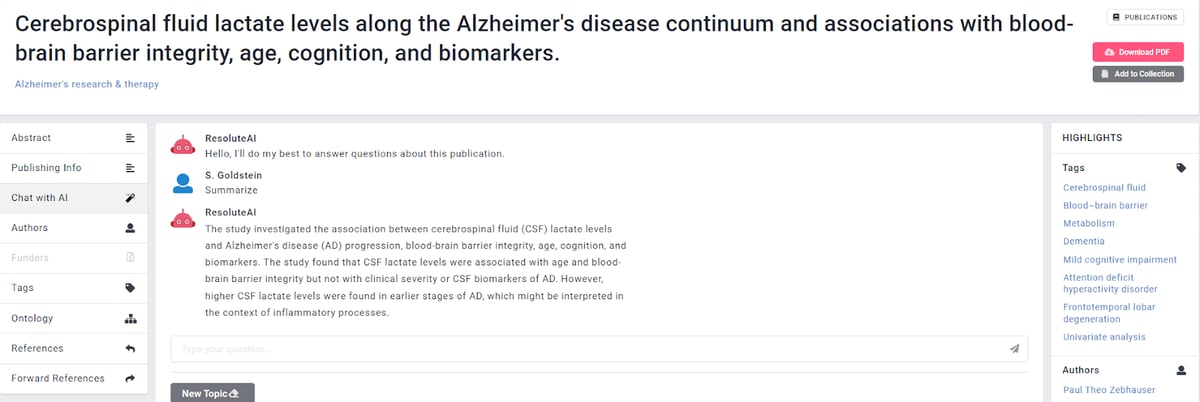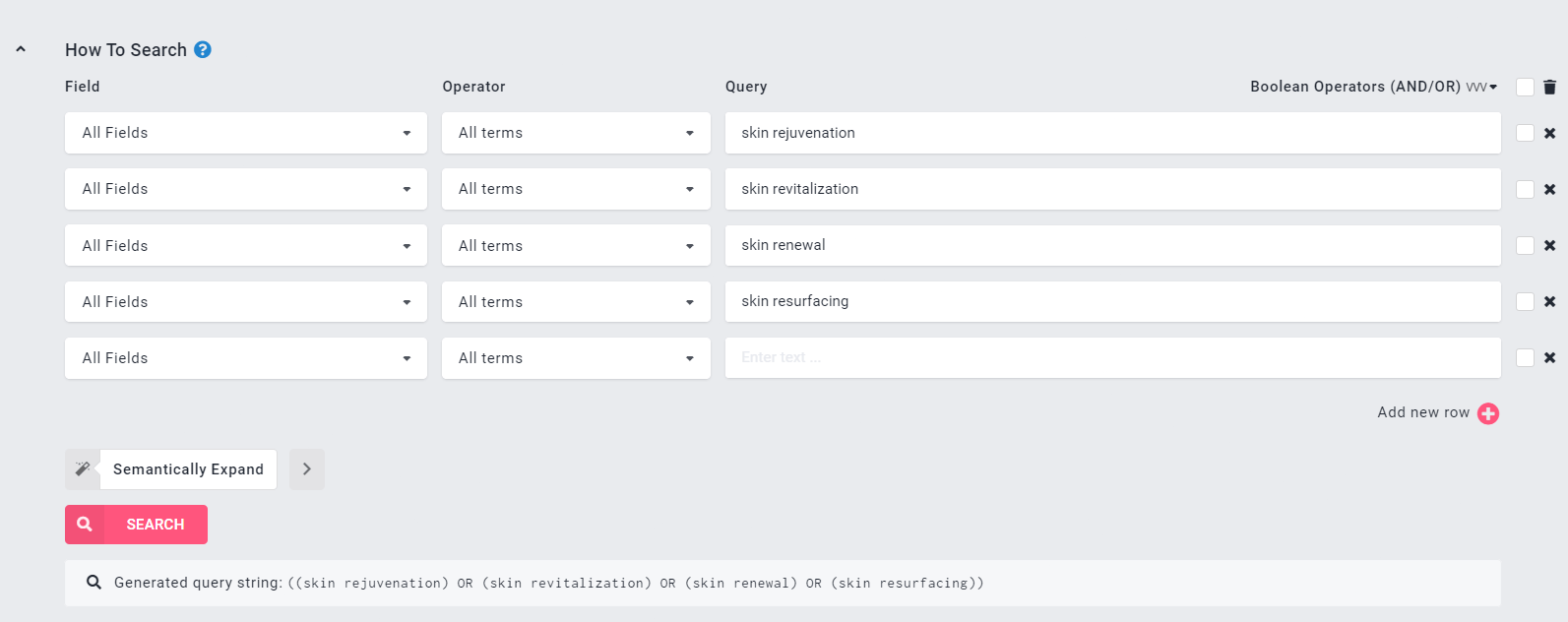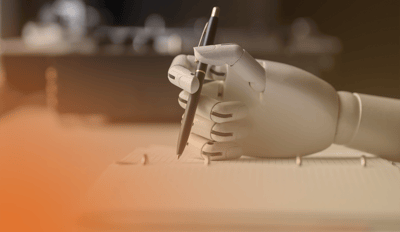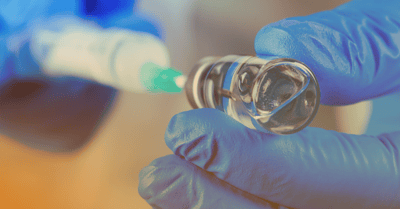The upside and downside of Large Language Models (LLMs), particularly ChatGPT, have been written about extensively since ChatGPT was released in November 2022. LLMs can do amazing things, but it’s been proven in many domains that they are not consistently or amazingly accurate. So, what is a corporate researcher or innovation expert to do?
ResoluteAI, now a part of Research Solutions' product family, has been experimenting with ChatGPT for several months and has incorporated some of its capabilities into Foundation, our scientific research platform (for reasons related to customer privacy, we have not yet deployed ChatGPT within Nebula, our enterprise search service). Foundation contains mostly public domain information, such as patents, academic literature, and clinical trials data, as well as a number of datasets from the US Food & Drug Administration. We have found that when used with a user-defined set of inputs (documents selected from our platform) the summarization and question-answering capabilities of ChatGPT work exceptionally well. We have structured our prompts to ignore the ChatGPT corpus and to answer “I don’t know” to queries where the answer is not in the selected documents.
Most of our customers spend a good amount of time doing online research - searching for and finding a number of documents and then determining, of the documents that were found, which are the most relevant for the project at hand.
For example, looking for recent (since 2021) academic literature on the blood-brain barrier that mentions Amyloid beta-peptide, Foundation will find 28 articles. We have incorporated the ability to ask the document questions, perhaps the most useful of which is to summarize:

Or, you can ask a more specific question, such as “How are amyloid beta-peptides described in this article?"

Patent Results Summaries & Comparison
Expanding on the summarization capabilities of ChatGPT, we deliver summaries for a set of patent results and assess the similarities and differences between the patents in the set. Below are summaries and a comparison of 10 recent US patents focused on the blood-brain barrier that also mention amygdalin.
Summaries
1. Systems And Methods For Delivering Therapeutic Agents To The Brain Using Tms
(WO2020072589) This document talks about a new way to give medicine to a specific part of the brain. They use a special material that can be moved by a magnet and put it in the patient's body. Then, they use a magnet to move the material to the part of the brain that needs medicine. This makes tiny holes in the brain's protective barrier, which lets the medicine get to the right spot.
2. Apparatus and methods of transcranial stimulation to adjust sensory cortical dendritic spine neck membrane potentials for altering consciousness
(US2022126055) Scientists are studying how to change a person's consciousness by using a technique called transcranial stimulation. They want to adjust the way the membranes in the sensory cortex dendritic spine necks work. These membranes are important for consciousness.
3. Methods For Diagnosing Or Treating Post-Traumatic Stress Disorder, And Compositions Therefor
(CA3111620) This document talks about ways to help people who have post-traumatic stress disorder (PTSD). One way is to give them medicine that stops a certain chemical reaction in their body. Another way is to test their blood to see if they have too much of this chemical reaction, which could mean they have or might get PTSD. The document also talks about medicine and tools that can help diagnose and treat PTSD.
4. Compositions And Methods For Intranasal Delivery Of Pregnenolone
(JP2021522170) This document talks about a new way to treat diseases or disorders that happen when a chemical in the brain called acetylcholine isn't working well. The method involves putting a substance called pregnenolone in just one nostril, which makes the acetylcholine in that part of the brain work better. This can help with problems in the amygdala, which is a part of the brain that controls emotions.
5. Phthalazine derivatives, and preparation method, pharmaceutical composition and application thereof
(CN106854207B) Scientists have created new compounds that can be used to treat certain medical conditions by targeting a specific receptor in the body. These compounds have a specific formula and can come in different forms. The scientists have also figured out how to make these compounds and how to use them in medicine.
6. (no title)
(CN111448308) This document talks about a new way to make and use tiny particles called adeno-associated virus (AAV) to help prevent or treat diseases.
7. Substituted [1,2,4]triazolo[3,4-a]phthalazines as modulators of GABAA receptor activity
(WO2019174577) This invention is about a new chemical compound that can be used in medicine. The compound is made in a certain way and can be turned into a medicine that can help with certain medical conditions. The compound has a special effect on a certain part of the brain called α5-GABA A.
8. Acoustic Energy Treatment
(AU2020227619) This invention is about ways to help older people who don't have a brain disease that affects their memory. The invention suggests using sound waves to improve their brain function. By applying safe levels of sound energy to certain parts of the brain, it can help improve their memory and thinking abilities.
9. Small Molecule Antagonist To Pacap Receptor And Uses Thereof
(WO2020168068) This document talks about a new invention that can help treat different kinds of brain problems. These problems include stress, pain, addiction to drugs or alcohol, and anxiety. The invention works by blocking certain receptors in the brain that are related to these problems.
10. Anti-Nmda Receptor Antibodies And Methods Of Use
(WO2020204977) Scientists have created a type of antibody that can attach to a specific part of a receptor in the brain called the NMDAR. They made this antibody using genetic material that is very similar to certain sequences called SEQ ID NOs. These antibodies can be used to test for a condition called ANRE. In some cases, multiple antibodies are used to make sure the test is accurate.
Comparison
Documents 1 and 4 are similar in that they both discuss new ways to treat brain-related medical conditions. Document 7 is also related to brain function, but focuses on a specific part of the brain. Documents 2, 3, 5, 6, 8, 9, and 10 are all unique in their own ways, discussing topics such as changing consciousness, treating PTSD, creating new compounds for medical use, using sound waves to improve brain function, and creating antibodies for testing brain conditions. Overall, the documents cover a range of topics related to brain function and medical treatment, with some similarities and many unique aspects.
In these examples, we are using ChatGPT to analyze or process content/documents we have provided as input, and have included in our prompts specific instructions not to use the ChatGPT corpus.
ChatGPT Use Case: Expanding Search Terms
There is one, low-risk application where we are using the ChatGPT corpus: a user can semantically expand search terms so that their query of the Foundation databases can be more comprehensive. An example of this is seen below, where we have used ChatGPT to semantically expand our “skin rejuvenation” query.

By typing in “skin rejuvenation” and selecting Semantically Expand, a Boolean string is created that adds "skin revitalization," "skin renewal," and "skin resurfacing" to my original search terms. This process can be executed multiple times and the user has the ability to accept or ignore any or all of the suggestions made by the model, meaning the user remains in complete control of the ChatGPT outputs.
We will be expanding our use of LLMs in the near future, focusing on the creation of “landscapes” for technology scouting, patent analysis, clinical trial literature reviews, and competitive intelligence. Again, we will only create landscapes using documents and content provided by each user for each specific task to practically eliminate the possibility of hallucinations. In addition, references will be cited in each landscape, and we will make it impossible for ChatGPT to know which of our customers is requesting a landscape on which subject.
Transforming Innovation Workflows: Research Solutions Acquires ResoluteAI
With Research Solutions' acquisition of ResoluteAI, an advanced search platform powered by Artificial Intelligence (AI) and Natural Language Processing (NLP), we are building on our dedication to bring the latest technological advancements directly to our valued users, empowering them to fully harness the benefits of AI capabilities.
We invite you to see Foundation and Nebula in action and book a demo of our AI tools today. Our team is excited to show you how ResoluteAI's products can help you achieve more.



